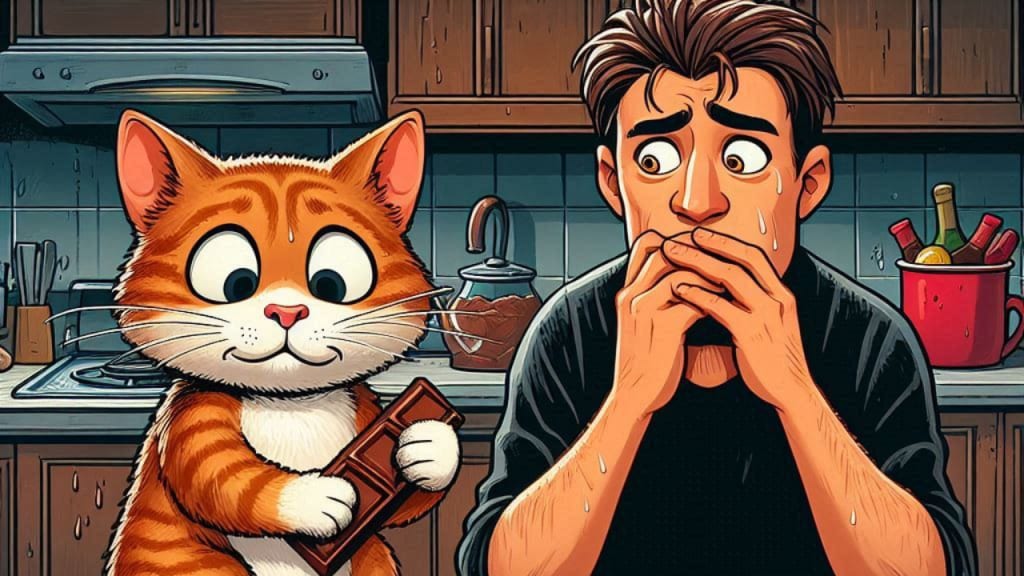Can Cats Eat Chocolate? Understanding the Risks and What to Do
Explore the dangers of chocolate and feline health. Find out why "Can Cats Eat Chocolate" is a critical query for every cat owners peace of mind.

If there’s one thing that doesn’t go with cats, it’s chocolate - theobromine and caffeine in this most delicious of human snacks are intensely toxic to cats (and dogs, for that matter) and, if they are consumed, can cause severe symptoms and even death.
If you celebrate Halloween, Christmas or Valentine’s Day at your home, it’s especially important to keep all chocolate treats, baked goods or candy bars away from your cat.
The introduction is quite general in the first sentence by setting the context for the article, which is explaining the danger of chocolate being toxic to cats. In the next sentence, it is possible to see the text focuses on the compounds that cause toxicity by being specific. Then the text briefly refers to the consequences that toxicity causes in the third sentence, while suggesting importantly they are relevant to some specific occasions such as holidays that require more attention to dealing with this issue.
What Makes Chocolate Harmful to Cats
Chocolate contains two key compounds that make it toxic for cats - theobromine and caffeine.
- The Role of Theobromine | Its major toxic principle is theobromine, with concentrations 3-10 times those of caffeine. Theobromine is rapidly absorbed from the gastrointestinal tract and is widely distributed to body tissues. It competitively inhibits cellular adenosine receptors, causing central nervous system stimulation, tachycardia and diuresis.
- Effects of Caffeine | Although present in lower concentrations, caffeine is a methylxanthine like theobromine, and both contribute to the toxic effects of chocolate poisoning. Caffeine like theobromine is a stimulant and diuretic, increasing heart rate and blood pressure, and causing increased urination. Both compounds can result in restlessness, hyperactivity, tremors and cardiac arrhythmias in cats.
- Why Cats are Sensitive | Cats are more sensitive to theobromine and caffeine than humans. And their bodies metabolise these compounds much more slowly than ours, allowing them to accumulate to dangerous levels in the bloodstream. Just a little chocolate can be a problem, and it’s even more serious for small cats.

Symptoms of Chocolate Poisoning in Cats
Common Symptoms
If your cat has eaten chocolate recently, look for the following common symptoms while calling your veterinarian:
- Gastrointestinal distress (nausea, vomiting, diarrhea)
- Signs of restlessness or agitation
- Increased heart rate
- Excessive thirst and urination
- Lack of appetite
Advanced Symptoms
As the toxicity progresses, more severe symptoms may manifest, including:
- Fast breathing or panting (unusual in cats)
- Seizures
- Tremors or shaking
- Difficulty walking or muscle tremors
- Abnormal heart rhythm
- Coma
How Long After Ingestion Symptoms Appear
The symptoms begin approximately half an hour after the chocolate is consumed and last for up to 12 hours. The occurrence and intensity of symptoms depend on the mass of chocolate consumed as well as the cat’s size. But the gist is this:
- Mild gastrointestinal symptoms like vomiting may appear within an hour of ingestion.
- More severe neurological and cardiovascular symptoms usually peak within 6-12 hours.
- Symptoms can last from 24 to 96 hours, depending on their severity.
Regardless of your cat’s clinical signs or not, if your cat ate some chocolate, call your veterinarian or take your cat to the emergency room immediately because signs can come on rapidly.

What to Do if Your Cat Eats Chocolate
- Immediate Steps | So if you find your cat eating chocolate, get help. Immediately. Call your veterinarian or the Pet Poison Helpline (855-764-7661). Do not try to cause vomiting at home. Home induction of vomiting is unsafe.
- When to Visit the Vet | Get your cat to the vet immediately, no matter how small the amount of chocolate it has eaten. With chocolate poisoning, early intervention is key so that the antidote works. Take any remaining chocolate packaging with you to help the vet identify the type and amount of chocolate eaten.
- Veterinary Treatments | Depending on the amount of time since ingestion and your cat’s condition, your vet may decide to induce vomiting (if it has not already occurred spontaneously), remove any remaining toxins before they are absorbed from the gastrointestinal tract. Several of these treatments may be performed, including administration of activated charcoal, which is absorbed by the toxin and helps diminish further absorption from the gastrointestinal tract; intravenous fluids; medications to manage symptoms such as agitation, abnormal heart rate/rhythm; sedatives if needed; and hospitalisation for monitoring in severe cases.
- Determining Amount and Type of Chocolate Consumed | Tell your vet your cat’s weight and approximate how much and what kind of chocolate was eaten. If possible, save packaging to identify ingredients. This is particularly important if your cat consumed fruit and nut chocolate, as these may contain an additional poison such as raisins or macadamia nuts. This helps assess risk and decide on treatment.
Preventing Chocolate Poisoning
Keeping Chocolate Out of Reach
A pet parent’s abode is chock full of potential sources of chocolate - candy and baked goods, baking chocolate and chocolate drinks, and dietary supplements containing chocolate for their palatability. There are so many ways in which a cat might have access to chocolate in the home that it is hard to believe any pet parent would provide chocolate for their cat intentionally. While most cats don’t manage to jump too high, they have bee known to land on the tops of bookshelves and other tall furniture!
Make sure you keep all types of chocolate (not just bars but candies and baked goods with chocolate) away from your cat throughout the major holiday seasons when chocolate is usually plentiful in the home (Halloween, Christmas, Hanukkah, Valentine’s Day and Easter).
Wrapping up chocolate as gifts and placing them under the Christmas or Yule tree is not a good idea if you happen to share your home with a pet, nor is leaving out Easter baskets. The candy can easily be ripped and shredded by a cat to get to the chocolate, and not only that, it’s well-known that string can hang up and cause a foreign body obstruction.
Safe Alternatives
Though chocolate is made of cocoa beans, carob chips are made from carob tree pods, thus real ‘chocolate chip’ is what our pets should have instead. Inside the pod is a sweet pulp which is dried, roasted and ground into powder. Both carob powder and chips can be bought.
Besides being completely free of the toxic compounds found in chocolate, carob contains a moderate concentration of fibre and potassium, as well as vitamins. Pets should not receive any food new to them without having gotten a vet’s OK first As with any ‘junk food’ (and yes, this counts), carob should be given only in moderation.
Educating Household Members
If cat owners are aware that chocolate could be poisonous to a cat and why it could happen, they will be inclined to avoid the consumption of it. Communication is powerful in saving the cat before the consumption occurs. As a team, we should do our best to educate our customers on preventive measures. This will help avoid situations, like a cat consuming too much chocolate.In conclusion, educating cat owners on the dangers of chocolate consumption is an important step in mitigating these risks. To do so, veterinarians and other veterinary professionals should engage in an active communication of these dangers and empower pet owners to make educated decisions.
- Keeping all chocolate-containing products, including baking ingredients, in locked containers or well above cat head-height
- Using sealed containers that are difficult for cats to open.
- Make sure everyone in the family knows what the risks are, and doesn’t allow anyone to eat chocolate.
- Watching out lest you put chocolate treats or desserts somewhere they’ll be accessible to cats, who can jump and climb onto high surfaces.
- Tight-fitting pedestal trash cans or ones that are kept in cabinets so cats can’t dig around for stray Hershey’s wrappers.
- Not giving cats table scraps containing chocolate, so they don’t develop a taste for it.
Until such time as they can guarantee a chocolate-safe environment in the home, and are able to render immediate medical help in case your cat appears to have ingested chocolate, cat owners may want to be extremely careful.
Conclusion
Poisonous compounds in chocolate such as theobromine and caffeine make chocolate extremely hazardous to cats. Ingestion of only small amounts of chocolate can result in serious gastrointestinal, neurological and cardiovascular symptoms in cats. Veterinary care is key, and the sooner it is initiated after ingestion occurs, the better the chances for a full recovery.
Makes sure chocolate products are well away and out of the reach, but make sure that those taking charge of the cat know the dangers and are primed with a carob treat or two instead. Cats should be lucky, as we know, but they can also be fearless about exploring smells and tastes. By being watchful and taking appropriate action, many a cat owner will keep their kitties safely away from the life-threatening effects of chocolate poisoning.
FAQs
- What is the minimum amount of chocolate that can be toxic to cats?
The toxicity of chocolate in cats depends on the type and amount of chocolate ingested. There is no specific threshold as even small amounts can be harmful.
- What should be done if a cat consumes chocolate?
If a cat consumes chocolate, it is crucial to administer activated charcoal orally as soon as possible to absorb the toxins. Additionally, a veterinarian may need to provide medications to control muscle tremors, seizures, and to regulate heart and respiratory functions due to chocolate poisoning.
- How quickly do symptoms of chocolate poisoning appear in cats?
Symptoms of chocolate poisoning typically manifest within six to 12 hours after a cat has ingested chocolate. These symptoms can persist for three to four days in severe cases and may include diarrhea and vomiting.
- What are the effects of a cat licking a small amount of chocolate?
If a cat licks a small amount of chocolate, it may experience mild gastrointestinal symptoms and possible hyperactivity. Moderate poisoning can cause more severe effects, particularly on the cardiovascular system. The specific symptoms depend on both the quantity and type of chocolate ingested.
About the Creator
Ahmed Khaled
My name is Ahmed Khaled, and I like to write strange, interesting, and useful topics as well.
Enjoyed the story? Support the Creator.
Subscribe for free to receive all their stories in your feed. You could also pledge your support or give them a one-off tip, letting them know you appreciate their work.






Comments (1)
Cats and chocolate was good learning! Well written 🫥